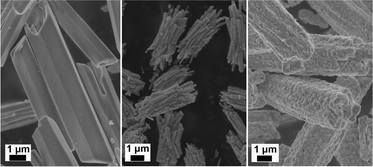Monodisperse and uniform Y6O5F8:RE3+ (RE = Yb, Er, and Ho) microarchitectures with various morphologies have been constructed by a facile surfactant-assisted hydrothermal route, and their up-conversion luminescence and NIR quantum cutting properties were investigated. Hollow hexagonal prisms, microbundle gatherings by rods, and solid hexagonal prisms were designed by employing CTAB, PVP, and EDTA as additives, respectively. Under 980 nm excitation, the Y5.34O5F8:0.6Yb3+, 0.06Er3+ samples obtained using different additives exhibit similar emission spectra profiles with predominating peaks at 670 nm; the Y5.34O5F8:0.6Yb3+, 0.06Ho3+ samples give green emissions with the strongest peaks around 544 nm. The NIR quantum cutting for the Y6O5F8:Yb3+, Ho3+ samples was identified by the NIR emission spectra upon both 360 and 450 nm excitation. The corresponding quantum cutting mechanisms were discussed through the energy level diagrams, in which a back-energy-transfer from Yb3+ to Ho3+ was first proposed to interpret the spectral characteristics. A modified calculation equation for the quantum efficiency of Yb3+–Ho3+ coupled by exciting at 450 nm was suggested according to the quantum cutting mechanism. The efficient NIR luminescence and quantum cutting in Yb3+, Ho3+ co-doped Y6O5F8 reveal a possible application in modifying the solar spectrum to enhance the efficiency of silicon solar cells.

You have access to this article
 Please wait while we load your content...
Something went wrong. Try again?
Please wait while we load your content...
Something went wrong. Try again?


 Please wait while we load your content...
Please wait while we load your content...